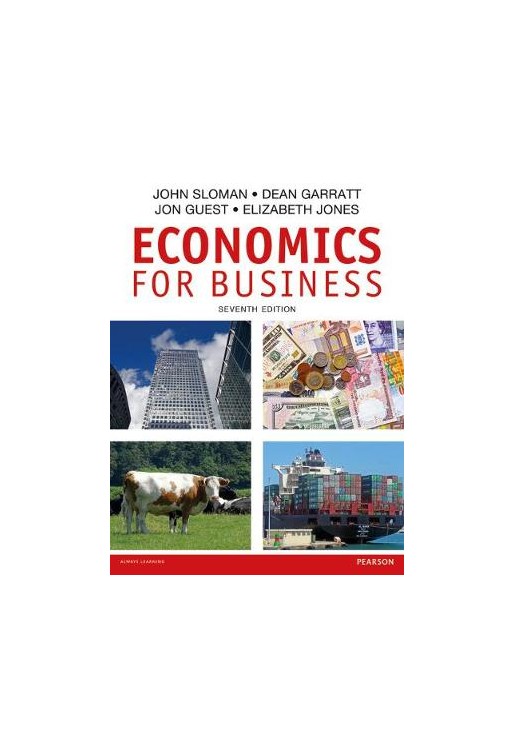


Were you looking for the book with access to MyEconLab? This product is the book alone and does NOT come with access to MyEconLab. Buy Economics for Business, 7th editon with MyEconLab access card (ISBN 9781292082196) if you need access to MyEconLab as well, and save money on this resource. You will also need a course ID from your instructor to access MyEconLab.
This new edition of Economics for Business uses up-to-date case studies to examine the key issues facing the business world today. Looking at everything from the impact of the financial crisis to the operation of individual business, the 7th edition illustrates how economic theory relates to real business issues in a clear, accessible and engaging way designed to help students excel.
Looking for economics in action? Search online for the Sloman Economics News Site, a blog that’s updated several times a week with current affairs and topical stories, all linked to your textbook so you can explore the background to the issues more deeply.
John Sloman was Director of the Economics Network from its foundation in 1999 until 2012, and is now Visiting Fellow at the University of Bristol where the Network is based. John is also Visiting Professor at the University of the West of England, Bristol.
Dean Garratt is Principal Teaching Fellow in the Department of Economics at the University of Warwick.
Jon Guest is a National Teaching Fellow of the Higher Education Academy and a Principal Lecturer in the School of Economics, Finance and Accountancy at Coventry University. Jon is also an Associate of the Economics Network and a Lecturer on economics courses delivered to departments across the UK government.
Elizabeth Jones is a Principal Teaching Fellow and the Dean of Students in the Economics Department at the University of Warwick. Elizabeth is also a Lecturer on economics courses non-economists delivered to departments across the UK government.
About the authors
Custom publishing
Preface
Publisher’s acknowledgements
Part A BUSINESS AND ECONOMICS
1 The business environment and business economics
1.1 The business environment
1.2 The structure of industry
1.3 The determinants of business performance
Box 1.1 A perfect partnership
Box 1.2 The biotechnology industry
Summary
Review questions
2 Economics and the world of business
2.1 What do economists study?
2.2 Business economics: the macroeconomic environment
2.3 Business economics: microeconomic choices
Box 2.1 Looking at macroeconomic data
Box 2.2 What, how and for whom
Box 2.3 The opportunity costs of studying economics
Summary
Review questions
Appendix: Some techniques of economic analysis
Summary to appendix
Review questions to appendix
3 Business organisations
3.1 The nature of firms
3.2 The firm as a legal entity
3.3 The internal organisation of the firm
Box 3.1 Exploiting asymmetric information
Box 3.2 Managers and performance
Box 3.3 The changing nature of business
Summary
Review questions
Part end – additional case studies and relevant websites
Part B BUSINESS AND MARKETS
4 The working of competitive markets
4.1 Business in a competitive market
4.2 Demand
4.3 Supply
4.4 Price and output determination
Box 4.1 UK house prices
Box 4.2 Stock market prices
Box 4.3 Controlling prices
Summary
Review questions
5 Business in a market environment
5.1 Price elasticity of demand
5.2 The importance of price elasticity of demand to business decision making
5.3 Other elasticities
5.4 The time dimension of market adjustment
5.5 Dealing with uncertainty
Box 5.1 The measurement of elasticity
Box 5.2 Elasticity and the incidence of tax
Box 5.3 Adjusting to oil price shocks
Box 5.4 Don’t shoot the speculator
Summary
Review questions
Part end – additional case studies and relevant websites
Part C BACKGROUND TO DEMAND
6 Demand and the consumer
6.1 Marginal utility theory
6.2 Demand under conditions of risk and uncertainty
6.3 The characteristics approach to analysing consumer demand
Box 6.1 Calculating consumer surplus
Box 6.2 The marginal utility revolution: Jevons, Menger, Walras
Box 6.3 Adverse selection in the insurance market
Box 6.4 Rogue traders
Summary
Review questions
7 Demand and the firm
7.1 Estimating demand functions
7.2 Forecasting demand
Box 7.1 The demand for lamb
Summary
Review questions
8 Products, marketing and advertising
8.1 Product differentiation
8.2 Marketing the product
8.3 Advertising
Box 8.1 The battle of the brands
Box 8.2 Advertising and the long run
Summary
Review questions
Part end – additional case studies and relevant websites
Part D BACKGROUND TO SUPPLY
9 Costs of production
9.1 The meaning of costs
9.2 Production in the short run
9.3 Costs in the short run
9.4 Production in the long run
9.5 Costs in the long run
Box 9.1 The fallacy of using historic costs
Box 9.2 How vulnerable are you?
Box 9.3 UK competitiveness: moving to the next stage
Box 9.4 Minimum efficient scale
Box 9.5 Fashion cycles
Summary
Review questions
10 Revenue and profit
10.1 Revenue
10.2 Profit maximisation
Box 10.1 Costs, revenue